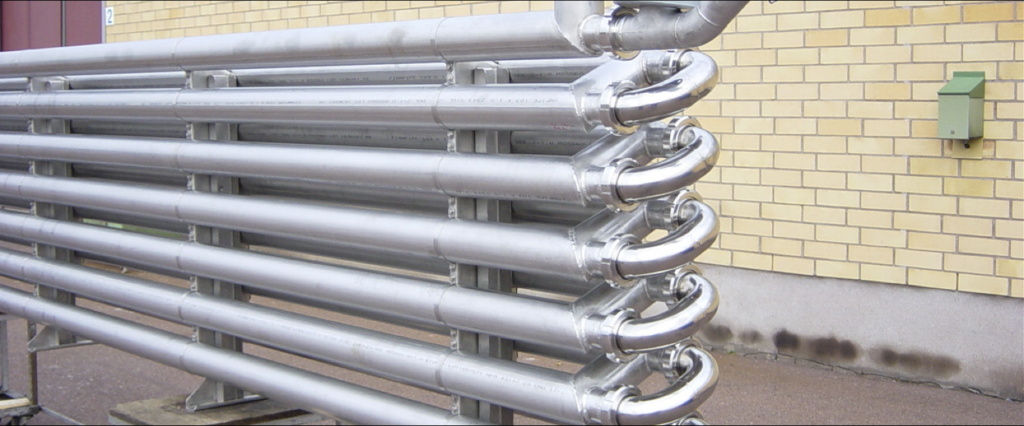Residential buildings have become more energy efficient when it comes to both the buildings envelope and ventilation, in these areas there is a fairly large range of solutions and well-proven methods on how to save energy in residential buildings.
The energy demand for hot water can account for an increasing proportion of the building’s energy consumption. One way of recovering some energy from hot water usage is to extract the energy in the wastewater. To extract the energy from the wastewater a heat exchanger can be used.
The two most common are the horizontal- and vertical wastewater heat exchangers. The vertical heat exchanger is mostly suitable for single family houses and the horizontal are used in industry, sport complex, hotels and multifamily houses.
System
The heat exchanger is built with copper or stainless steel to endure the rough environment. The wastewater and cold water meet in separate tubes in the counter current heat exchanger for an efficient heat transfer. Heating the cold water with help of the wastewater reduces the energy requirement for heating tap water.
Example
One example on a horizontal wastewater heat exchanger is the Ekoflow produced in Dalarna Sweden by Isakssons. Ekoflow utilizes the heat energy in wastewater to provide effective energy recovery, achieving efficiencies of up to 85%. Compact design, twin-tube counterflow heat exchanger, acid-resistant stainless-steel tubes, capacity under own pressure (no pump): approx. 4 liters/sec and cleaning hatch to ensure easy maintenance. https://isakssons.com/ekoflow-heat-exchanger/
Pros
- Use the energy in wastewater
- Mechanically reliable systems
- Usable for many other situations for example hotels, swimming pools, sport complexes and industrial.
- Profitable when the hot water usage is high
Cons
- May be difficult to implement in older buildings.
- Uncertain annually efficiency
- Depended on people behavior
- Profitability?
Study’s
A multi-dwelling house on Gävle Strand, which uses a wastewater system to take advantage of thermal energy from wastewater. The method used to find out how much the system accumulates per month. An interesting question has been to see how much the system has reduced the energy cost. The profitability of the system does not prove to be profitable for this apartment block. The repayment period amounts to 27 years. (Hurlov, 2019)
In a study by Blomsterberg (2015) they installed wastewater heat exchangers in seven apartment buildings. The measurements from study did show a much lower result than expected. The measured yearly efficiency varies between 3 and 10%, witch can be compared to the theoretical potential of 20 -25%.
References
Blomsterberg, Å. (2015). Värmeåtervinning från spillvatten i flerbostadshus. Malmö: WSP Environmental.
Hurlov, A. (2019). Värmeåtervinning med spillvatten i flerbostadshus. Gävle: Högskolan Gävle.
ykvis, A. (2012). Värmeåtervinning ur spillvatten i befintliga flerbostadshus . Stockholm: KTH.













